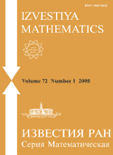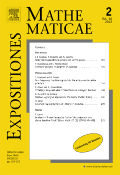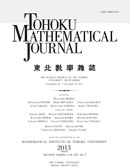
IZVESTIYA MATHEMATICS
Scope & Guideline
Connecting Scholars through Peer-Reviewed Excellence
Introduction
Aims and Scopes
- Advanced Differential Equations:
The journal publishes research on various types of differential equations, including quasilinear, elliptic, parabolic, and fractional equations. These papers often explore stability, solvability, and boundary value problems. - Algebraic Structures and Their Applications:
A significant focus is on algebraic theories, including Lie algebras, group theory, and their applications in geometry and topology. This area highlights the interplay between algebraic constructs and other mathematical domains. - Functional Analysis and Operator Theory:
The journal features studies on functional spaces, operator theory, and their implications in mathematical physics and other applied fields. This includes work on Sobolev spaces, Rademacher chaos, and various operator norms. - Geometric Analysis and Topology:
Research in this area includes geometric structures, manifold theory, and topological properties. Papers often delve into the relationship between geometry and analysis, exploring concepts such as Chern classes and homotopy. - Mathematical Physics and Applications:
The intersection of mathematics and physics is well-represented, with papers on topics like quantum control, wave equations, and statistical mechanics. This scope emphasizes the applicability of mathematical theories in physical contexts.
Trending and Emerging
- Fractional Calculus and Differential Inequalities:
There is an increasing number of papers exploring fractional calculus and its applications in various fields, including fluid dynamics and material science. This trend reflects a growing recognition of the importance of non-integer calculus in modeling complex phenomena. - Stochastic Processes and Random Walks:
The journal has seen a rise in publications addressing stochastic processes, particularly in the context of random walks and probabilistic models. This trend indicates a heightened interest in the statistical properties of mathematical models. - Nonlinear Analysis and Optimization:
Recent works demonstrate a significant focus on nonlinear analysis, particularly in the context of optimization problems. This includes studies on critical growth conditions and variational methods, which are increasingly relevant in applied mathematics. - Geometric Topology and Algebraic Geometry:
Emerging themes in geometric topology and algebraic geometry have gained traction, with researchers exploring deep connections between these fields. This reflects a broader trend towards interdisciplinary approaches that link algebraic methods with geometric intuition.
Declining or Waning
- Classical Mechanics and Dynamical Systems:
While still relevant, the frequency of papers focusing specifically on classical mechanics and dynamical systems has seen a decline. This shift may indicate a broader interest in more abstract mathematical theories or computational approaches. - Elementary Number Theory:
Papers dedicated to elementary number theory concepts have become less common. This could suggest a trend towards more complex or higher-dimensional problems, leaving traditional number theory less explored. - Computational Mathematics:
Research focused on numerical methods and computational approaches appears to be waning. The decreasing number of publications in this area may reflect a saturation of previous work or a shift towards theoretical advancements.
Similar Journals

St Petersburg Mathematical Journal
Advancing Mathematical Frontiers with Every IssueSt Petersburg Mathematical Journal, published by the American Mathematical Society, is a distinguished platform that fosters research and discourse in the fields of mathematics, specifically focusing on Algebra and Number Theory, Analysis, and Applied Mathematics. With an ISSN of 1061-0022 and an E-ISSN of 1547-7371, this journal has been a reliable source of cutting-edge mathematical research since its inception in 2003 and continues to publish high-quality content through 2024. Although not open-access, it offers valuable insights and advances the mathematical community's understanding, as indicated by its respectable impact factor and Scopus rankings across various categories—landing in the Q3 quartile across three significant mathematical disciplines. Researchers, professionals, and students are encouraged to contribute and engage with this journal, as it remains a vital resource for promoting collaboration and discovery within the ever-evolving field of mathematics.

EXPOSITIONES MATHEMATICAE
Advancing Mathematical Frontiers with Rigorous ResearchEXPOSITIONES MATHEMATICAE, published by Elsevier GmbH, stands as a significant journal in the realm of mathematics, catering primarily to researchers, professionals, and students. With an ISSN of 0723-0869 and an E-ISSN of 1878-0792, this journal has made its mark in the academic community, boasting a Q2 classification in the miscellaneous mathematics category for 2023, illustrating its prominence within its field. The journal addresses a diverse scope of mathematical topics, encouraging the publication of original research and innovative theories while maintaining rigorous academic standards. As it converges from 2004 to 2024, EXPOSITIONES MATHEMATICAE continues to be an essential resource for advancing mathematical knowledge and fostering scholarly communication, despite being a non-open-access publication. Its location in Munich, Germany further anchors it within a rich intellectual tradition, providing accessibility for the mathematical community worldwide.

Dissertationes Mathematicae
Pioneering Insights in Mathematical Disciplines.Dissertationes Mathematicae is a prestigious academic journal published by the Polish Academy of Sciences Institute of Mathematics (IMPan), renowned for its contributions to the field of mathematics since its inception. With an impressive Q1 ranking in the miscellaneous mathematics category for 2023 and positioned at Rank #73 out of 399 in General Mathematics according to Scopus, this journal serves as a pivotal platform for disseminating high-quality research and innovative theoretical developments. Spanning from 2000 to 2024, it focuses on a broad range of mathematical disciplines, encouraging interdisciplinary collaboration and advancing mathematical understanding globally. While it currently does not offer open access, the journal is highly regarded in academic circles and continues to attract submissions from respected researchers and institutions. With a commitment to excellence and a notable impact factor, Dissertationes Mathematicae plays a crucial role in the ongoing development of mathematical theories and applications, making it an essential resource for researchers, professionals, and students alike.

Journal of Mathematical Study
Connecting Researchers Through Mathematical ExplorationJournal of Mathematical Study, published by GLOBAL SCIENCE PRESS, stands as a prominent platform dedicated to advancing knowledge in the field of mathematics. With ISSN 2096-9856 and E-ISSN 2617-8702, this journal aims to disseminate high-quality research articles, reviews, and theoretical studies that encapsulate the latest developments and innovative methodologies within mathematical sciences. Although it is currently not open access, the journal strives to provide comprehensive insights into a spectrum of mathematical disciplines, catering to researchers, students, and professionals seeking to deepen their understanding of both pure and applied mathematics. The Journal of Mathematical Study plays a critical role in fostering scholarly communication and collaboration, making it an essential resource for anyone invested in the rapidly evolving world of mathematical research.

HOUSTON JOURNAL OF MATHEMATICS
Fostering Innovation in Miscellaneous MathematicsHOUSTON JOURNAL OF MATHEMATICS, published by the University of Houston, serves as a valuable platform for disseminating significant findings in the field of mathematics, specifically within the realm of miscellaneous mathematics. Despite its current categorization in Q4 for 2023, the journal plays a crucial role in fostering academic discussion and exploration among researchers, professionals, and students alike. With its ISSN 0362-1588, the journal has been publishing original research since 1996, with a recent gap filled from 2022 to 2023, thereby continuing to contribute to the mathematical community. While it does not currently offer open access options, the journal's commitment to quality research maintains its relevance within the field and invites submissions that can elevate its standing. Located in the vibrant city of Houston, Texas, the journal not only emphasizes theoretical advancements but also encourages applied mathematical research that intersects with other disciplines, enhancing its significance and reach.

Rendiconti del Circolo Matematico di Palermo
Showcasing Innovative Research in Mathematics.Rendiconti del Circolo Matematico di Palermo, published by SPRINGER-VERLAG ITALIA SRL, is a revered journal in the field of mathematics, emphasizing the cultivation and dissemination of mathematical knowledge since its inception in 1887. With its ISSN 0009-725X and E-ISSN 1973-4409, this esteemed publication has continued to thrive, showcasing innovative research, comprehensive reviews, and thoughtful discussions from diverse areas in mathematics, particularly in its Q2 ranking within the miscellaneous mathematics category. Its historical significance is underscored by its convergence of publications across numerous years, including its notable periods from 1887 to 1916, 1919 to 1938, and beyond, effectively capturing the evolution of mathematical thought. Though not open access, the journal remains an essential resource for researchers, professionals, and students aiming to stay updated with the latest advancements and methodologies in the ever-evolving landscape of mathematics. With its Scopus rank placing it in the top 25th percentile, Rendiconti del Circolo Matematico di Palermo continues to be a cornerstone for scholarly dialogue and development in its domain.

TOHOKU MATHEMATICAL JOURNAL
Advancing the Frontiers of Mathematical KnowledgeTOHOKU MATHEMATICAL JOURNAL, published by TOHOKU UNIVERSITY, is a distinguished academic journal committed to the advancement of mathematical research. Established in 1949, the journal has sustained a long-standing tradition of disseminating high-quality, peer-reviewed articles that contribute significantly to various branches of mathematics. With its scope encompassing a broad range of topics within the field, TOHOKU MATHEMATICAL JOURNAL aims to foster intellectual exchange and innovation among mathematicians worldwide. Though currently not an open-access publication, it is indexed in Scopus, holding a respectable Q2 ranking in the miscellaneous mathematics category as of 2023, which signifies its relevance and influence in the academic community. Researchers, professionals, and students alike will find valuable insights and contemporary developments that reflect the journal's dedication to excellence in mathematical scholarship.

Archivum Mathematicum
Bridging Theory and Practice in MathematicsArchivum Mathematicum is an open-access journal dedicated to the broad spectrum of Mathematics, published by Masaryk University, Faculty of Science in the Czech Republic. Since its inception in 1965, this journal has provided a platform for the dissemination of research and advancements within the mathematical sciences. It spans converged years from 2004 to 2024, ensuring ongoing relevance in a rapidly evolving discipline. Currently categorized in Q4 for 'Mathematics (miscellaneous)' and ranked #316/399 in general mathematics by Scopus, the journal aims to foster a collaborative environment for researchers, practitioners, and students alike, encouraging submissions that contribute to mathematical theory, applications, and education. With its commitment to open access, Archivum Mathematicum is a vital resource for anyone seeking to stay informed about emerging trends and findings in the field.

Mediterranean Journal of Mathematics
Bridging Theory and Practice in the World of MathematicsThe Mediterranean Journal of Mathematics, published by SPRINGER BASEL AG, is a prominent platform dedicated to the advancement of mathematical research and education. Since its inception in 2004, this journal has been pivotal in disseminating high-quality research across various fields of mathematics, currently holding a notable Q2 ranking in the miscellaneous mathematics category as of 2023. With its ISSN 1660-5446 and E-ISSN 1660-5454, the journal enjoys a respected position in the academic community, evident by its Scopus rank of 129 out of 399 in General Mathematics, placing it in the 67th percentile. While primarily a subscription-based journal, it remains committed to providing a comprehensive resource for researchers, professionals, and students, fostering dialogue and exploration within the mathematical sciences. The Mediterranean Journal of Mathematics, based in Basel, Switzerland, continues to contribute significantly to the evolution of mathematical theory and practice, marking its relevance as we approach its 20th anniversary in 2024.

Methods of Functional Analysis and Topology
Advancing the frontiers of mathematics through functional analysis and topology.Methods of Functional Analysis and Topology is a distinguished open-access journal published by INST MATHEMATICS, based in Ukraine. Fostering a scholarly environment since 2006, this journal serves as a vital platform for researchers and practitioners in the fields of functional analysis, topology, and mathematical physics. Despite its Q4 ranking in key categories such as Analysis, Geometry and Topology, and Mathematical Physics as of 2023, the journal addresses a growing need for accessible research and dialogue within these domains. With ISSN 1029-3531, it marks a commitment to advancing knowledge in mathematics, ensuring that innovative ideas and methodologies can reach a broader audience. As scholars continue to explore complex mathematical concepts, Methods of Functional Analysis and Topology stands as an integral resource, encouraging collaboration and understanding amidst the diverse landscapes of mathematics.